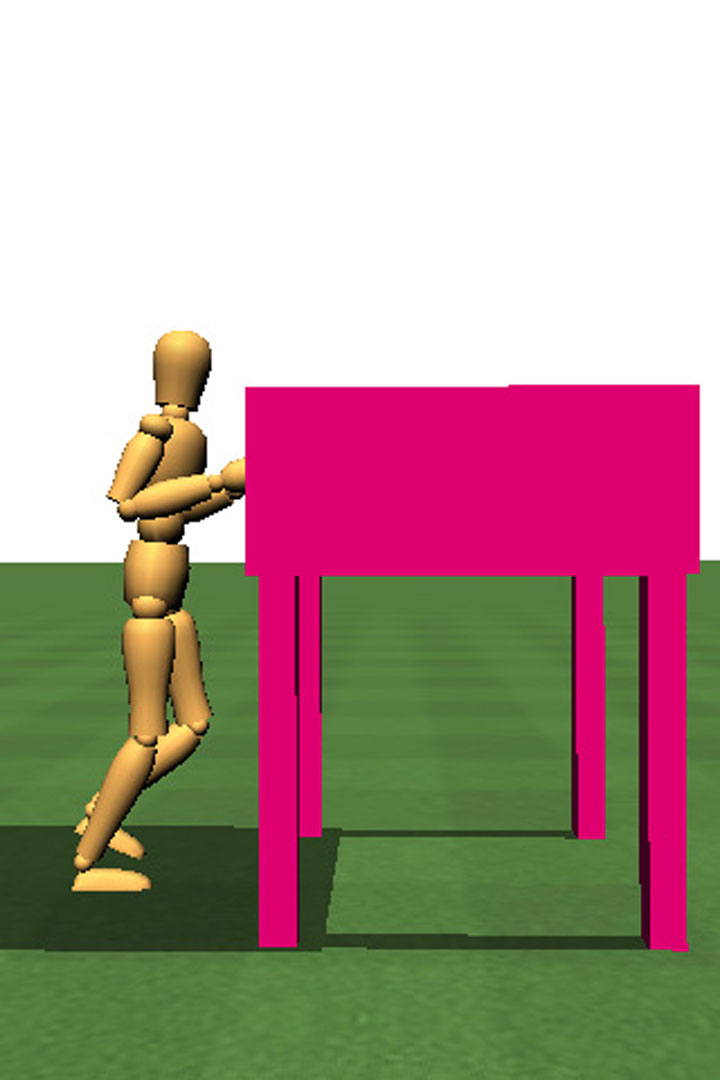“Continuation methods for adapting simulated skills” by Yin, Coros, Beaudoin and Panne
Conference:
Type(s):
Title:
- Continuation methods for adapting simulated skills
Presenter(s)/Author(s):
Abstract:
Modeling the large space of possible human motions requires scalable techniques. Generalizing from example motions or example controllers is one way to provide the required scalability. We present techniques for generalizing a controller for physics-based walking to significantly different tasks, such as climbing a large step up, or pushing a heavy object. Continuation methods solve such problems using a progressive sequence of problems that trace a path from an existing solved problem to the final desired-but-unsolved problem. Each step in the continuation sequence makes progress towards the target problem while further adapting the solution. We describe and evaluate a number of choices in applying continuation methods to adapting walking gaits for tasks involving interaction with the environment. The methods have been successfully applied to automatically adapt a regular cyclic walk to climbing a 65cm step, stepping over a 55cm sill, pushing heavy furniture, walking up steep inclines, and walking on ice. The continuation path further provides parameterized solutions to these problems.
References:
1. Abe, Y., Liu, C. K., and Popovic, Z. 2004. Momentum-based parameterization of dynamic character motion. In Proc. Symposium on Computer Animation, 173–182. Google ScholarDigital Library
2. Auslander, J., Fukunaga, A., Partovi, H., Christensen, J., Hsu, L., Reiss, P., Shuman, A., Marks, J., and Ngo, J. T. 1995. Further experience with controller-based automatic motion synthesis for articulated figures. ACM Trans. on Graphics 14, 4, 311–336. Google ScholarDigital Library
3. da Silva, M., Abe, Y., and Popović, J. 2008. Simulation of human motion data using short-horizon model-predictive control. Computer Graphics Forum (Proc. Eurographics) 27, 2.Google ScholarCross Ref
4. Faloutsos, P., van de Panne, M., and Terzopoulos, D. 2001. Composable controllers for physics-based character animation. Proc. ACM SIGGRAPH, 251–260. Google ScholarDigital Library
5. Grzeszczuk, R., and Terzopoulos, D. 1995. Automated learning of muscle-actuated locomotion through control abstraction. Proc. ACM SIGGRAPH, 63–70. Google ScholarDigital Library
6. Hodgins, J. K., and Pollard, N. S. 1997. Adapting simulated behaviors for new characters. In Proc. ACM SIGGRAPH, 153–162. Google ScholarDigital Library
7. Hodgins, J. K., Wooten, W. L., Brogan, D. C., and O’Brien, J. F. 1995. Animating human athletics. In Proc. ACM SIGGRAPH, 71–78. Google ScholarDigital Library
8. Laszlo, J. F., van de Panne, M., and Fiume, E. 1996. Limit cycle control and its application to the animation of balancing and walking. In Proc. ACM SIGGRAPH, 155–162. Google ScholarDigital Library
9. Liu, C. K., Hertzmann, A., and Popović, Z. 2006. Composition of complex optimal multi-character motions. In Proc. Symposium on Computer animation, 215–222. Google ScholarDigital Library
10. Nocedal, J., and Wright, S. J. 1999. Numerical Optimization. Springer.Google Scholar
11. Popović, Z., and Witkin, A. 1999. Physically based motion transformation. In Proc. ACM SIGGRAPH, 11–20. Google ScholarDigital Library
12. Raibert, M. H., and Hodgins, J. K. 1991. Animation of dynamic legged locomotion. In Proc. ACM SIGGRAPH, 349–358. Google ScholarDigital Library
13. Safonova, A., Hodgins, J. K., and Pollard, N. S. 2004. Synthesizing physically realistic human motion in lowdimensional, behavior-specific spaces. ACM Trans. on Graphics (Proc. SIGGRAPH), 514–521. Google ScholarDigital Library
14. Seeger, A. 2006. Recent Advances in Optimization. Springer.Google Scholar
15. Sharon, D., and van de Panne, M. 2005. Synthesis of controllers for stylized planar bipedal walking. In International Conference on Robotics and Automation.Google Scholar
16. Sok, K. W., Kim, M., and Lee, J. 2007. Simulating biped behaviors from human motion data. ACM Trans. on Graphics (Proc. SIGGRAPH), Article 107. Google ScholarDigital Library
17. Spall, J. C. 2003. Introduction to Stochastic Search and Optimization. Wiley. Google ScholarDigital Library
18. Stewart, A., and Cremer, J. 1992. Beyond keyframing: An algorithmic approach to animation. In Proceedings of Graphics Interface, 273–281. Google ScholarDigital Library
19. Sulejmanpasic, A., and Popović, J. 2005. Adaptation of performed ballistic motion. ACM Trans. on Graphics 24, 1, 165–179. Google ScholarDigital Library
20. Treuille, A., McNamara, A., Popović, Z., and Stam, J. 2003. Keyframe control of smoke simulations. In ACM Trans. on Graphics (Proc. SIGGRAPH), 716–723. Google ScholarDigital Library
21. van de Panne, M., and Fiume, E. 1993. Sensor-actuator networks. In Proc. ACM SIGGRAPH, 335–342. Google ScholarDigital Library
22. van de Panne, M., and Lamouret, A. 1995. Guided optimization for balanced locomotion. In Proc. EG Workshop on Computer Animation and Simulation, 165–177.Google Scholar
23. van de Panne, M. 1996. Parameterized gait synthesis. IEEE Computer Graphics and Applications 16, 2 (March), 40–69. Google ScholarDigital Library
24. Witkin, A., and Kass, M. 1988. Spacetime constraints. In Proc. ACM SIGGRAPH, 159–168. Google ScholarDigital Library
25. Wooten, W. L. 1998. Simulation of leaping, tumbling, landing, and balancing humans. PhD thesis, Georgia Inst. Technology. Google ScholarDigital Library
26. Yin, K., Loken, K., and van de Panne, M. 2007. Simbicon: Simple biped locomotion control. ACM Trans. on Graphics (Proc. SIGGRAPH), Article 105. Google ScholarDigital Library





